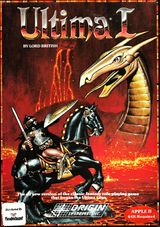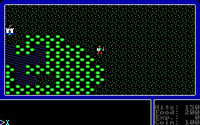Ultima I
Ultima I: The First Age of Darkness is the first official game in the series (Akalabeth being the unofficial start). It was registered for a copyright on September 2, 1980[1] and officially released it in June 1981[2] by California Pacific Computer Co. for the Apple II. Without the subsequent installments that would establish it as the first in a series, the game was originally published simply as Ultima.
The new title – essentially an update to Akalabeth – included a plot, quests, a map, dungeons, a user interface, and a tile-based graphics system to improve the game. Since the initial release, there have been many recodes and ports to different operating systems, with the 1986 version the most well-known and available. Ultima would go on to inspire many other RPGs of the early to mid-eighties, laying the foundation for a whole genre.
Gameplay[edit]
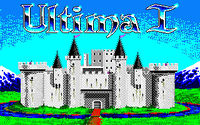
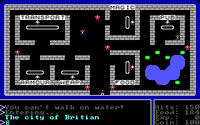
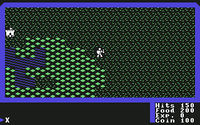
At a time when computer games were at a much younger stage, Ultima I was something very new and had exceptionally detailed graphics. While complex for its time, it lacked practically all features of later installments, making it a simple hack-n-slash game.
Plot[edit]
Spoiler warning: Plot and/or ending details follow.
The wizard Mondain attacks Sosaria with his hordes of evil creatures and foul magic, threatening to crush the world beneath his heel. The player, in the role of the Stranger, travels to Sosaria for the very first time, to stop Mondain's plans from succeeding. However, the evil wizard has become immortal thanks to a magic gem, and his fortress is unreachable, making the quest seemingly insurmountable.
The Stranger must fulfill several quests for the various kings of the land, in order to obtain four different colored gems, before venturing into outer space to battle malicious "starwalking" creatures. After this is done, a freed princess reveals the location of a hidden time machine, with which Mondain's fortress can be breached, and at a time when he was vulnerable. Confronting Mondain, the Stranger shatters the Gem of Immortality so that Mondain can be defeated, and Sosaria free of his evil. Thus, Sosaria is finally safe.
Spoilers end here.
Development[edit]
Unlike Akalabeth, Ultima I was from the start a commercial product. The original version was a two-man production: only Richard Garriott and Ken W. Arnold were part of its development. Garriott and Arnold coded the game for the Apple II while they were attending the University of Texas, shortly after the success of Akalabeth. Most of the game was written in BASIC by Garriott; Arnold wrote routines to paint the tiled world and generate simple sound effects in assembly.[3] This is the first commercial game to use tile graphics to display the surroundings.
Early on, the title “Ultimatum” was chosen for the game, but the name was trademarked by a board game already, so the publisher suggested truncating it to "Ultima."
Versions and Ports[edit]
- Main article: Computer ports of Ultima I
Ultima was re-released on December 23rd, 1986 by Origin on a number of other platforms, including Apple II, IBM PC and C64. Details were changed and the whole game got a face-lift to make it more appealing to the players of the mid-eighties. Origin decided to rewrite Ultima in assembly language, change the graphics and some of the towns, names and puzzles in the game.
There are not many differences between the Apple II, C64 and IBM PC versions of the 1986 re-release, apart from the graphical superiority of the PC-port (by the standards of the time) and a number of bugs newly introduced in the PC-port that do not exist in the other two.
An enhanced Apple IIgs port was made, but is an extremely rare find. Versions for other systems do exist, including versions for Atari 8-bit, FM Towns, and MSX2.
Releases[edit]
The original release of Ultima I was successful, at a time when CRPGs were something completely new, and started the Ultima series. Reviewers at the time were impressed by its color graphics and detailed gameplay.[4] It sold 50,000 copies. The re-release of 1986 sold better, with the series already established and well-known.
In 1981, Ultima was released by California Pacific Computer Co. on 5.25” floppy disks for the Apple II. It featured a 12 page playbook, an 8.5” x 11’ cover art page, a player reference card and one 5.25” floppy disk. The box artwork displayed a knight fighting a dragon in a subterranean environment. Sometime after the release of this version, the publishers declared bankruptcy and Richard Garriott had to negotiate a deal with Sierra On-Line for the publishing rights.
Ultima 1 – The Original was released by Sierra On-Line on 5.25” floppy disks for the Atari 8-bit. It featured a 12 page manual, an Atari reference card, an errata flyer and one 5.25” floppy disk. The box artwork changed with the change of publishers.
In 1986, Ultima I: The First Age of Darkness was released by Origin on 5.25” floppy disks for the Apple II. The box artwork changed back to the original artwork with title and logo alterations made. Later in 1986, Ultima I ports to the Commodore 64 and the PC were also released. While the cover of the re-release is the same as the original, the name was changed to “Ultima I”, to reflect that it is the beginning of the series.
Ultima I (as well as Ultima Underworld and ten other classic games) was included in the July 2000 issue of PC Gamer magazine, CD-ROM edition.
This game was included in several compilations:
- Ultima Trilogy I II III (1989)
- Ultima Value Pak (1990) as part of the Ultima Trilogy I
- Ultima I-VI Series (1993)
- Ultima Collection (1998)
In Japan, the game was included in the compilation Ultima Complete.
Included with the game[edit]
The original release of Ultima I from California Pacific included the following:
- The book Playbook.
- The Player Reference Card.
The 1986 re-release, together with the game, contained the following things:
- The book The First Age of Darkness.
- The Player Reference Card.
- Paper maps of the four continents of Sosaria.
- A cloth bag containing five Coins of the Kingdom (1 gold, 3 silver, 1 copper).
[edit]
- For bugs in this game, see Ultima I bugs.
- For Easter eggs and real-life references in this game, see Ultima I real-life references and Easter eggs.
- For a map viewer, see Ultimatrix.
- For a saved game editor, see Ultima Saved Game Editor.
- For a walkthrough, see Ultima I walkthrough.
- For more detailed information on character statistics, see Character attributes in Ultima I.
Trivia[edit]
- When Ultima I was remade in 1986, the balrogs of the original were marginally renamed to balrons (the spelling already used in Ultima II, Ultima III, and Ultima IV), likely to avoid legal trouble with the copyright owners of J. R. R. Tolkien's The Lord of the Rings.
- The painting used for the back cover art of the 1986 re-release is identical to that of the Ultima III box.
- South Park co-creator Trey Parker cites Ultima I and Ultima II as early examples of his keen interest in role-playing games, which would inspire the development of The Stick of Truth and The Fractured but Whole, two role-playing video games set in the South Park universe.[5]
- As Denis Loubet revealed, the cover was his first ever commission from Richard Garriott. Garriott also hired him to draw the startup screen for the original version of the game. As Loubet muses, the graphics tablet he had to use was so shoddily constructed it broke down constantly – yet he did get the job done.
Gallery[edit]
External Links[edit]
- The collectible Ultima – Ultima I
- Hacki's Ultima I Nitpicks
- Ultima I on Ultima Aiera
- Ultima I: The First Age of Darkness on Wikipedia
- Ultima I – The First Age of Darkness on C64 Wiki
References[edit]
- ↑ “Reg. #PA-317-501”. U.S. Copyright Office. Retrieved 2007-08-08.
- ↑ "List of Top Sellers". Computer Gaming World. Golden Empire Publications Inc.: September-October 1982. Page 2.
- ↑ Maher, Jimmy. “Ultima, Part 1”. The Digital Antiquarium. 2012-02-10. Retrieved 2013-05-18.
- ↑ Softline, Volume 1.1, September 1981. Page 18.fckLR
- ↑ “South Park 20th Anniversary SDCC 2016 Hall H Panel with Trey Parker and Matt Stone”. YouTube. 2016-07-23. Retrieved 2017-10-17.
